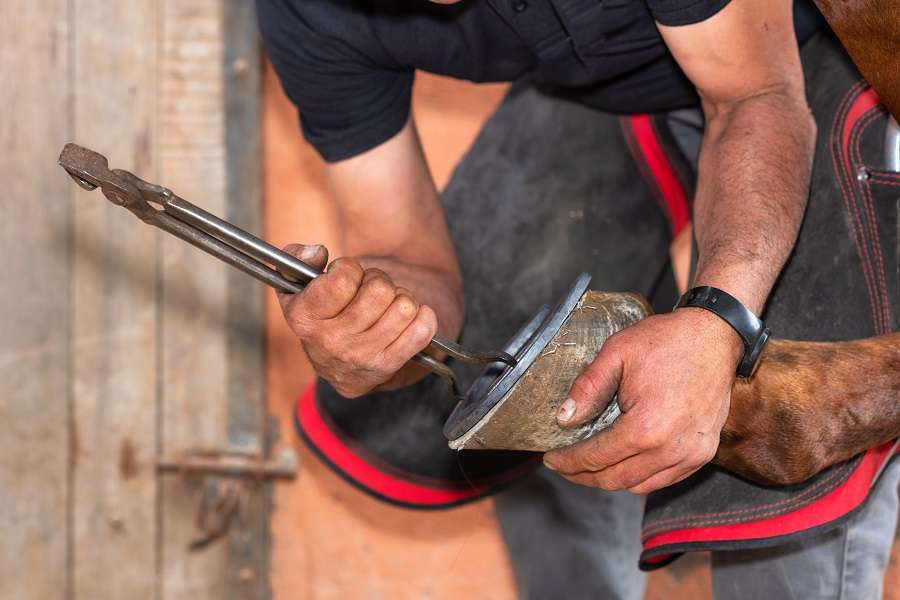
Shoeing or shodding horses is a pretty common practice among horse owners. Horses have been wearing shoes for thousands of years. Some historians believe that we’ve been shoeing horses since the ancient Roman times.
Even with such a long history, many modern horse owners still don’t know that much about horseshoes. So today, we’re going to answer all the questions you’ve always wanted to ask about horseshoes but have never had the chance to. And remember, it never hurts to familiarize yourself with your ferrier.
Do Horseshoes Hurt My Horse?
The answer to this question isn’t straightforward, but it depends. Horse hooves are made with keratin, the same material that makes our nails and hair. Like human nails, horse hooves themselves do not contain any pain receptors, so nailing a shoe into a hoof does not hurt.
However, what can hurt is an improperly mounted horse shoe. When a horseshoe is mounted incorrectly, it can rub the soft tissue of the sole and the frog, causing pain and leaving your horse lame. To ensure that horseshoes don’t hurt your horse, make sure that you only work with a professional ferrier.

Are Horseshoes Necessary For My Horse’s Health?
The simple answer is that horseshoes are not necessary for a horse’s health. However, they can help protect your horse’s hooves and feet. If your horse walks on rough surfaces like stone or concrete, shoeing your horse can prevent wear and tear.
Furthermore, the wear and tear from rough materials is not always even, and when their hooves are uneven, it can affect their gait and stress their joints. Whether or not shoeing your horse protects their health depends on your horse’s lifestyle.
Why Do We Use Horseshoes?
Horseshoes have many uses. The most common is to avoid the stress and wear and tear from running on rough surfaces. However, horseshoes can be used for corrective shoeing. Corrective shoes are custom-made to your horse and help horses with bone or muscular problems.
Horseshoes can also be used for traction, and they can improve grip on the ground. Some horse owners use horseshoes for gait support. These are typically used on show horses and breeds that are known for high steps. In addition, they can be used for performance on race horses to help them have more grip, add support, and make them run faster and smoother.

Are There Different Kinds Of Horseshoes?
YeDo Horseshoes Hurt My Horse And Other Questions About Horseshoes You’ve Always Wanted To Ask
● Fullered Front Horseshoe: This is the most common type of horseshoe and is generally used on recreational horses. Fullered shoes get their name from the central crease. This crease fills with soil and helps your horse have a strong grip.
● Straight Bar Horseshoe: Straight bar horseshoes have a bar on the back of the shoe that runs along the heel. They protect the heel from bruising and can protect the bulbs behind the heel. These shoes are generally used for horses that experience laminitis.
● Egg Bar Horseshoe: Egg bar horseshoes are like straight bar horseshoes. They extend further to the back behind the heel and protect the rear portion of the hoof. They are typically used on horses with sheared heels and navicular syndrome for protection.
● Sliders: Sliders or sliding plates are wider than normal shoes and have a rocker toe. These shoes allow for exaggerated slides and are generally used on reined horses.
● Sliderette: A sliderette or a baby slider is similar to a slider but not as wide. They are generally used on rope horses that need some slide but also a little more control. They are also used on young reined horses.
● Rim Horseshoe: A rim horseshoe has a groove or a rim along the outside edge. This rim wraps around the outside edge. This shoe is designed for horses that run fast and stop a lot, such as barrel horses and horses in sports like polo.
These are just some of the more common styles of horseshoes. There are also patent bar horseshoes, aluminum race plates, rock and roll shoes, and many others. To pick the right shoe for your horse, talk to your ferrier.

Are There Modifications To Horseshoes?
There are a lot of modifications available for horseshoes that can help with performance. You can have a toe grab, which is a bar that wraps onto the toe of the horseshoe. This helps with grip at high speeds. There are toe extensions that can help horses that have severe injuries and can restrict the expansion of a cracked hoof. These prevent the horse from knuckling over from a lack of support.
There are also horseshoe studs that can give your horse added grip, especially on softer surfaces like grass and mud. Studs help reduce the risk of your horse slipping and falling.
How Do I Clean A Shoed Horse’s Hoof?
Cleaning a shoed horse’s hoof is relatively similar to grooming a barefoot horse’s hoof. You start by picking out the hoof area to remove any rocks, dirt, and manure. Work from the front of the foot to the back, taking extra care to clean the crease line between the horseshoe and the hoof.
Next, you’ll want to remove the excess debris with a stiff bristled brush. Make sure to clean around the top of the horseshoe on the outside. Then, apply Kiss A Frog Foot Wash along the soft tissue areas of the sole and the frog. Let it dry for 2-3 minutes.
Afterward, finish the job by spraying Jojoba Hoof Moisturizing Mist along the periople and let the product drip down. With a small cotton ball, spread the solution onto the hoof, allowing it to absorb. When you are cleaning, make sure to inspect the horseshoe for any issues like peeling, rust, or damage. If you notice anything unusual, contact your ferrier to fix the issue.
We hope this article has answered all of your most urgent questions about horseshoes. Let us know in the comments if you have any other inquiries about horseshoes, barefoot horses, and caring for your shoed horses with Equi-Spa products. We’ll happily answer them.

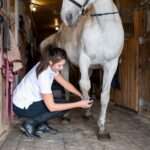

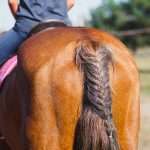

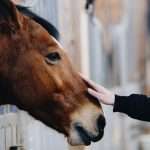
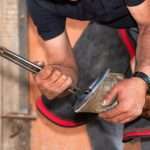

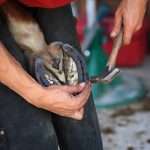

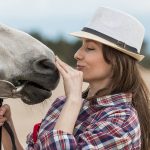
Excellent information!